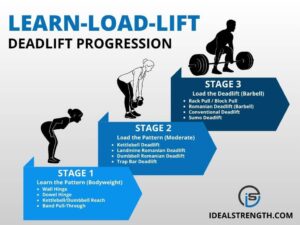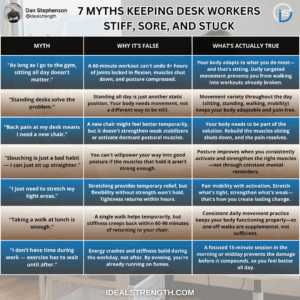You stretch your shoulders every day. Maybe you roll them back between emails, do doorway stretches during bathroom breaks, or follow along with a YouTube video before bed.
And by lunchtime? They’re tight again.
If you’ve been caught in this endless loop of temporary relief followed by the same nagging tension, you’re not alone. Most desk workers assume they just need to stretch more—or stretch better. But here’s the truth: stretching alone will never fix your shoulder tightness.
The real problem isn’t that your muscles are too short. It’s that they’ve forgotten how to do their job.
Table of Contents
ToggleWhy Stretching Alone Doesn’t Work
Let’s clear up a common misconception: your shoulders aren’t tight because of “bad posture.” They’re tight because your body is trying to protect you.
When you sit for hours in the same position, your nervous system interprets stillness as vulnerability. Without regular movement, your muscles don’t know if they can trust your joints to stay stable. So they do what any good security system would do—they lock things down.
That tightness you feel? It’s your body’s way of creating stability in the absence of strength and coordination.
Here’s where most stretching routines fall short: they temporarily lengthen the muscle tissue, giving you a brief sense of relief. But if you haven’t addressed the underlying weakness and lack of control, your nervous system simply re-tightens everything as soon as you return to your desk.
You can’t stretch your way out of a strength imbalance.
Think of it this way: if you had a wobbly table, you wouldn’t fix it by pulling the legs further apart. You’d reinforce the structure. Your shoulders work the same way. Lengthening without strengthening just creates more instability—and more protective tightness.
The Missing Piece: Strength and Movement Variability
This is where most desk workers get stuck. They focus exclusively on flexibility when what they actually need is the Rebuild phase—teaching your muscles to support your shoulders and spine with strength, stability, and coordination.
Your posture isn’t something you “hold.” It’s something your body creates moment-by-moment through coordinated muscle activation. When you spend eight hours in the same rounded position, certain muscles (like your chest and front shoulders) become overactive and short, while others (like your mid-back and rear shoulders) become weak and underactive.
The solution isn’t just to stretch what’s tight. It’s to strengthen what’s weak and retrain your body to move through varied positions throughout the day.
Here’s what that looks like in practice:
Sample Rebuild Movements
Band Pull-Aparts
Hold a resistance band in front of you at chest height with straight arms. Pull the band apart by squeezing your shoulder blades together, then slowly return. This wakes up your mid-back muscles—the ones that should be supporting your shoulders but have been on vacation while you type.
Start with 2 sets of 12-15 reps during your afternoon break.
Quadruped Scapular CARs (Controlled Articular Rotations)
Start on all fours with your hands directly under your shoulders. Keeping your arms straight, push through the floor to round your upper back toward the ceiling. Shift your weight forward, then draw your shoulder blades down and together as you sink your chest toward the floor. Shift back to feel the stretch, then press forward and reverse the entire circle. This movement trains your shoulder blades to move through their full range while your muscles learn to control every inch of that motion.
Perform 5 slow circles in each direction, focusing on smooth, controlled movement.
Prone Y-Raises
Lie face-down with your arms extended in a Y-shape above your head. Lift your arms a few inches off the ground, focusing on squeezing your shoulder blades together and down. This strengthens the muscles that pull your shoulders back and down—the exact opposite of the hunched position you’re in all day.
These movements don’t just make you feel better temporarily. They retrain your nervous system to support your shoulders properly, which means the tightness stops coming back.
How to Build Movement Breaks That Actually Work
The key isn’t doing more stretching—it’s creating strategic movement breaks that address the root cause of your tightness.
Here’s what effective movement breaks look like:
Make them active, not passive. Instead of just pulling your arm across your chest for 30 seconds, incorporate movements that require your muscles to activate and coordinate. Your body adapts to what you practice.
Keep them short and consistent. You don’t need 30-minute mobility sessions. Five minutes of targeted movement every two hours is far more effective than one long stretch at the end of the day when your body has already been locked in tension for hours.
Focus on what’s weak, not just what’s tight. Yes, your chest and front shoulders might feel tight, but the real problem is usually weak mid-back muscles and poor shoulder blade control. Strengthen the weak links, and the tight spots will relax on their own.
Build progressive challenge. Start with basic movements like wall slides and gradually increase the difficulty as your body adapts. Your nervous system needs to learn that it’s safe to move—and that your muscles are strong enough to support you without constant guarding.
The goal isn’t to become a mobility expert. It’s to create a sustainable system that keeps your body moving well throughout the workday so that tightness never builds up in the first place.
Build a System That Keeps You Moving Well
If you’ve been stuck stretching the same tight spots day after day, there’s a better way forward.
The Desk Athlete Blueprint is designed specifically for people like you—desk workers who are tired of temporary fixes and ready to address the actual problem. It walks you through a complete system:
- Reset what’s tight and restricted
- Rebuild what’s weak and underactive
- Recharge your body so you can work, train, and live without constant tension
You’ll learn which movements to prioritize, how to structure your breaks for maximum impact, and how to create lasting change instead of chasing temporary relief.
Your shoulders don’t have to feel like this. The tightness you’re experiencing isn’t permanent—it’s just a signal that your body needs a different approach.
Get The Desk Athlete Blueprint and start moving better today
Stop stretching the same tight spots and start building the strength and coordination that actually keeps them loose. Your shoulders (and your productivity) will thank you.
Have questions about shoulder tightness or desk worker pain? Drop a comment below—I read and respond to every one.









